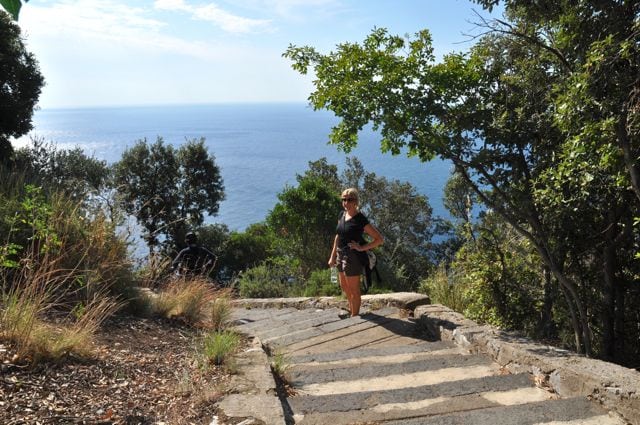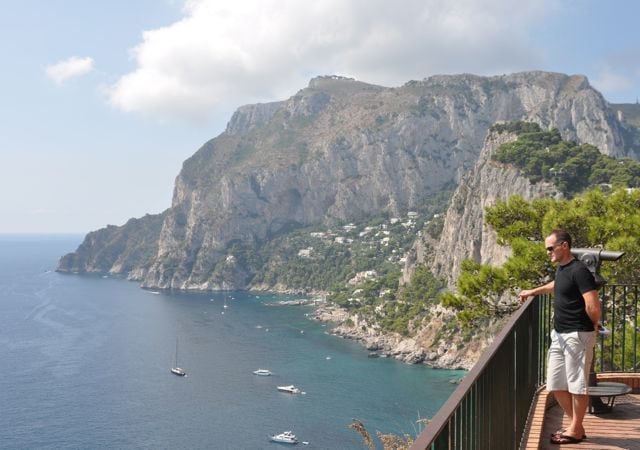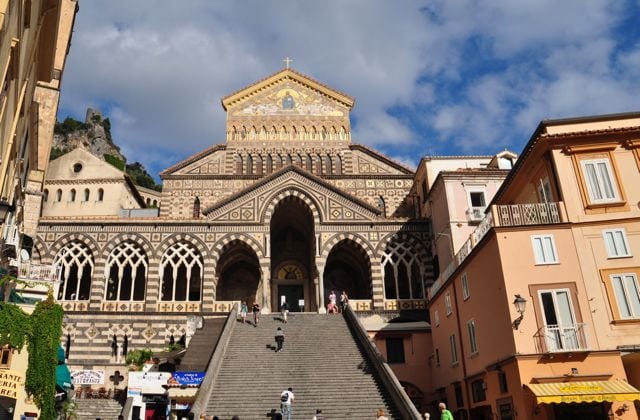Hiking Amalfi: Vistas, History & Italian Food
The pool at the Santa Catarina Hotel, Amalfi, Italy (speedos are welcome).
The Amalfi Coast as one of the world’s great paradoxes. On the one hand, it doesn’t get more glamourous, with its luxurious hotels and impossibly stylish boutiques and cafés. On the other hand, there is something perfectly rustic about the walking trails that follow former mule tracks, stone staircases, and coastal paths that have been trod for centuries.
The steep mountain slopes are dotted with lemon and olive trees, and everywhere, cliffs drop dramatically into the Mediterranean. Often visible are storied Capri and the Li Galli islands, where the sirens of mythology are said to have lured sailors to their deaths. The towns of Amalfi and Ravello, once important as maritime powers, are now UNESCO-protected and better known as the inspiration for dozens of famed writers and artists. With so much history and culture to experience, not to mention so much fabulous food and wine to taste, Amalfi is truly a walker’s paradise. And we haven’t even mentioned the limoncello…
HOW TO DO IT RIGHT – on two feet and earn those Italian calories!
It’s about a two-hour drive from Naples to Positano, a former fishing village that is now a chic seaside resort. Quaint pastel houses cling from cliffs, bougainvillea cascades over terraces, and the cobbled streets are lined with fashionable boutiques and picture-perfect cafés. There’s always a danger in starting a trip with something as spectacular as the Path of the Gods, but since there’s no such thing as an unspectacular hike on the Amalfi Coast, I’ve chosen to jump right in for your first walk. Known as the Sentiero degli Dei in Italian, this is probably the region’s most famous route, and for good reason. Offering dramatic views of coastline and sea, Capri and the Li Galli islands, the walking track is situated some 1,640 feet above sea level, half-way up Mount Sant’Angelo a Tre Prizi.
Winding through forests and across grassy terraces, it passes the Grotta del Biscotto (cave of the biscuit) and the charming villages of Nocelle and Montepertuso before eventually dropping into Positano via a series of ancient stone steps. Day two is all about Capri or, as Emperor Augustus called it in 29 BC, the “land of sweet idleness.”
In a private launch, I suggest heading across the Bay of Naples to the island of Capri—enjoy incredible views of the Sorrentine Peninsula and the Faraglioni Cliffs (the so-called “teeth” of Capri) en route. Arriving in Capri’s Marina Grande, you’ll ease into the day’s walk on the famed Phoenician Steps, or La Scala Fenicia, cut into the limestone cliffs by the Greeks and at one time forming the only connection between Anacapri and the marina. At the top, stop to visit the 19th century Villa San Michele before continuing out to the Belvedere della Migliera viewpoint and the Punta Carena lighthouse, and eventually up Monte Solaro. The highest point on the island at 1,026 feet, the summit offers views all the way to Mount Vesuvius on a clear day. Feel free to take the chairlift down, or continue on foot. Next, have poolside lunch at JK Capri before embarking on the afternoon walk—a coastal route from Capri Town that includes l’Arco Naturale and the 2000-year-old ruins of Tiberius’ Villa Jovis. Just before heading home—and after the crush of tourists has dissipated—visit some of Mother Nature’s finest work at the Blue Grotto.
On day three, walk between Positano and Amalfi via Praiano. Late afternoon, enjoy a guided walk through Amalfi, making stops at the Piazza del Duomo as well as at the Museo della Carta to learn about the town’s history of paper-making, and at the Civic Museum, where the extremely rare Tavole Amalfitane manuscript details the maritime laws that were in effect until 1570.
Leaving Amalfi for Ravello, you pass ruins of the former paper mills before entering into the Valle dei Mulini (Valley of the Mills). Our route follows along ancient mule tracks and panoramic paths en route to Pontone and Torre del Ziro, a medieval watchtower (one of the oldest on the Amalfi Coast) with spectacular views over Amalfi. Finally, you’ll arrive in Ravello, some 1,000 feet above the Bay of Salerno. André Gide described it as “nearer to the sky than it is to the sea,” and the town—serene compared to bustling Amalfi—was frequented by writers such as D H Lawrence, E M Forster, Virginia Woolf, and Gore Vidal, as well as the composers Wagner, Grieg and Verdi.
Take time to visit Ravello’s must-see sites: the Piazza Duomo and 11th century cathedral; the 13th century Villa Rufolo, famous for its gardens; and Villa Cimbrone, the 19th century estate that Greta Garbo made her home. Finally, walk to the Belvedere dell’Infinità (Belvedere of Infinity)—the panorama that Gore Vidal declared “the most beautiful in the world”—past numerous stone statues, rose gardens, temples and pavilions. Now you’ve earned at least a week of relaxation at one of my favorite resorts (below) on the Amalfi Coast.
HIKING & ITINERARY:
STAY:
This villa hotel, which dates from the late 19th century, overlooks the exquisite scenery of the Amalfi coast, and is surrounded by olive groves, fruit orchards, and bougainvillea. The family-owned five-star is located just a few minutes from the town of Amalfi and boasts 66 guest rooms and suites. There’s also an elegant restaurant and bar, a private beach club, plus a fitness centre and spa.
Each of the palazzo’s 32 and 11 suites is uniquely and traditionally decorated as befits history. It features all the usual amenities, including what is truly one of the best views in the world.
Next door to Sasso lies the even more luxurious Orient Express Hotel Caruso. Cool down in the infinite pool, taking in the sweeping Mediterranean views.
Perfection is the word that best describes this classic property nestled in the hillside of Positano.
Uber chic and no ceramic tiles at this beauty that is all about wood and water.
A 17th-century monastery converted into a boutique hotel and spa last year.
EAT:
My two favorite restaurants on the coast include Lo Scoglio on the Sea and Quattro Passi up in the village, both a short distance from Positano.







